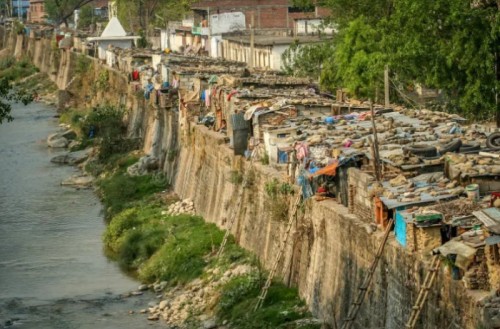
"Breaking the Chains of Poverty: Causes, Types, and Solutions"
-
- 0 Share
- 732 Views
Poverty is the situation where people are deprived of their basic needs and lack of voice, power and representative. It is not only about the lack of financial resources but also encompasses low levels of health and education, poor access to clean water and sanitation, inadequate physical security, and insufficient capacity and opportunity to better one's life. People living in poverty often experience social exclusion, dependency, and diminished capacity to participate in society, which can be understood as an aspect of unequal social status and inequitable social relationships.
ITS TYPES:
- Absolute poverty: It is that poverty in which people’s income is less than 2.15 US$ per day is considered poor (according to 2022 AD). According to this 15.1% Nepalese are under the poverty line.
- Relative poverty: It is the situation in which a person has enough income to sustain life but the income and living standard are lower compared to the rest of the community.
DIFFERENCE BETWEEN ABSOLUTE POVERTY AND RELATIVE POVERTY
| Absolute poverty | Relative poverty |
| 1. It is quantitative in nature. | 1. It is qualitative in nature. |
| 2. It deal with living standard of socially and economically deprived people. | 2. It deals with living standard of over all people. |
| 3. It is possible to express in figure. | 3. It is impossible to express in figure. |
| 4. Here, poverty alleviation is nearly possible. | 4. Here, poverty alleviation is almost impossible. |
ITS CHARACTERISTICS:
- Income Inequality: A significant portion of the population lives below the poverty line, with many struggling to meet basic needs. There is a stark income disparity between rural and urban areas.
- Unemployment and Underemployment: While many people are employed, a large number are either unemployed or underemployed, especially in rural regions. This leads to low income levels and poor economic stability.
- Agricultural Dependency: A large percentage of the population depends on agriculture for livelihood. The sector faces challenges like low productivity, lack of modern technology, and vulnerability to natural disasters, limiting income potential.
- Access to Basic Services: Access to education, healthcare, clean water, sanitation, and other basic services is limited in many rural areas. This affects the quality of life and future opportunities for many people living in poverty.
- Geographical Barriers: Nepal's mountainous terrain makes transportation and infrastructure development difficult, particularly in remote areas. This hinders economic growth and exacerbates poverty.
- Vulnerability to Natural Disasters: Nepal is prone to earthquakes, floods, and landslides, which can destroy homes, infrastructure, and crops, further deepening poverty, especially in rural areas.
- Cultural and Social Factors: Issues like caste discrimination, gender inequality, and social exclusion contribute to poverty, especially among marginalized groups like women, Dalits, and indigenous people.
- Lack of Access to Capital and Credit: Many people, particularly in rural areas, have limited access to financial services and credit, making it difficult for them to start businesses or improve their livelihoods.
- Low Levels of Education: Education levels are relatively low, particularly in rural areas, which limits people's ability to access better job opportunities or engage in more skilled economic activities.
- Dependency on Remittances: Many Nepali families depend on remittances from family members working abroad. This can be a double-edged sword, as it often creates an economic dependency while also contributing to the outflow of labor from the country.
ITS CAUSES:
- Geographical and Environmental Factors: Nepal's challenging topography, with its mountainous regions and difficult terrain, makes infrastructure development and access to markets, education, and healthcare challenging. This limits economic opportunities, especially in rural areas.
- Limited Access to Education: Many people, particularly in rural areas, have limited access to quality education. Low literacy rates and limited educational opportunities lead to a lack of skills, reducing people's ability to secure better-paying jobs and contributing to generational poverty.
- Low Agricultural Productivity: A significant portion of the population relies on agriculture for their livelihoods. However, the agricultural sector faces many challenges, including low productivity, outdated farming techniques, lack of access to modern technology, and vulnerability to climate change and natural disasters, all of which contribute to low income and food insecurity.
- Unemployment and Underemployment: While many people in Nepal are employed, the country still faces high levels of unemployment, particularly among youth. Additionally, many people are underemployed, working in low-wage jobs with little opportunity for advancement, which limits economic growth and perpetuates poverty.
- Political Instability and Governance Issues: Nepal has faced political instability for decades, including conflicts, transitions, and weak governance. These issues hinder the development of strong policies and institutions that could address poverty. Corruption and mismanagement of resources also divert funds away from poverty reduction efforts.
- Social Inequality: Nepal has a deeply entrenched caste system and social hierarchy. Dalits, indigenous communities, women, and other marginalized groups face discrimination and limited access to education, healthcare, and economic opportunities, which traps them in poverty.
- Limited Industrialization and Economic Diversification: Nepal's economy is still largely agrarian, and industrialization is limited. This lack of economic diversification restricts job creation in other sectors, leading to continued reliance on agriculture, which is vulnerable to external shocks like natural disasters and market fluctuations.
- Inadequate Infrastructure and Services: Poor infrastructure in rural areas, including roads, electricity, and water supply, hampers economic development. Additionally, inadequate healthcare and sanitation facilities contribute to poor health, further limiting people's ability to work and earn a living.
- Natural Disasters: Nepal is prone to earthquakes, floods, landslides, and other natural disasters. These events often lead to the destruction of homes, infrastructure, and crops, deepening poverty, particularly in vulnerable rural areas that lack the resources to recover.
- Dependency on Remittances: Many Nepalese people rely on remittances from family members working abroad, which can create an over-reliance on foreign income rather than fostering local economic growth. When migration opportunities decline or migrants face challenges abroad, the loss of remittances can significantly impact families' financial stability.
- Health Issues: Limited access to healthcare, particularly in rural areas, leads to high rates of illness and malnutrition, which can prevent people from working or pursuing educational opportunities. Poor health also places a significant financial burden on households, perpetuating poverty.
- Global Economic Factors: Nepal is a landlocked country, and its economy is highly dependent on trade with neighboring countries like India and China. Any disruptions in trade or global economic fluctuations can have a significant impact on the country's economic stability and poverty levels.
PRESENT STATUS OF ABSOLUTE POVERTY IN NEPAL
| SURVEY YEAR | URBAN POVERTY(%) | RURAL POVERTY(%) | NATIONAL POVERTY(%) |
| 1995/96 | 21.6% | 43.3% | 41.8% |
| 2003/04 | 9.6% | 34.6% | 30.8% |
| 2010/11 | 15.5% | 27.4% | 25.2% |
| 2012/13 | ~15% (est.) | ~25% (est.) | ~23.8% (est.) |
| 2015/16 | ~10% (est.) | ~22% (est.) | ~21.6% (est.) |
| 2018/19 | 7.0% | 20.0% | 17.4% |
Observations & Trends
Declining Poverty Rates:
- There has been a significant decline in absolute poverty over the years.
- Rural poverty remains consistently higher than urban poverty.
Urban vs. Rural Disparity:
- Urban poverty is lower due to better infrastructure, economic opportunities, and services.
- Rural poverty is higher due to dependence on agriculture, lack of access to services, and limited job opportunities.
Rapid Poverty Reduction Post-2000s:
- The decline from 1995/96 to 2003/04 was largely due to remittances, development programs, and better infrastructure.
- 2010/11 to 2018/19 saw further reductions due to improved government policies, economic growth, and rural-urban migration.
According to 2022/23:
- Nepal poverty- 15.1%(Based on below 1.9 US$, international poverty line)
- Multidimensional povety- 17.4%(Based on below 2.15 US$)
MULTIDIMENSIONAL POVERTY IS BASED ON FOLLOWING AREAS:
| Rural area poverty-28% |
| Urban area poverty-12.3% |
| hightes rate poverty area- Karnali province-39.5% |
| lowest rate poverty area-Bagmati proince-7% |
Please
